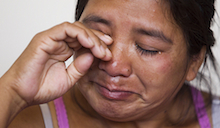 New figures from The Lancet reveal the tragedy of the scale of stillbirths, estimated at around 3 million worldwide, every year; or more than 8,200 stillborn babies a day.
New figures from The Lancet reveal the tragedy of the scale of stillbirths, estimated at around 3 million worldwide, every year; or more than 8,200 stillborn babies a day.
This vast number eclipses deaths from AIDS/HIV and many other diseases that get far more money. Perhaps not surprisingly, 98% of these are in low- and middle-income countries, which compounds the tragedy as most of these stillbirths would not occur if basic and comprehensive emergency obstetric care were as available, and as good, as in high-income countries.
Numbers on this scale can sometimes hide the personal impact and grief that each one of these stillbirths will have caused for those involved. Indeed, as one Lancet article comments:
‘One of the most devastating myths that surrounds stillbirth is that women who are accustomed to high infant mortality and high rates of stillbirth somehow feel the individual loss of a wanted pregnancy less than women living in high-income countries.’ http://www.thelancet.com/journals/lancet/article/PIIS0140-6736(11)60279-1/fulltext
Not only do they feel the loss of the pregnancy, but they also often bear an additional, if unwarranted, sense of responsibility or shame and, at times, blame from their husbands.
The controversy of these figures lies not just in the scale (though that is of course an important issue of inequity and resource provision) but also in the fact that many of these deaths are being ignored. They are being ignored – The Lancet claims – because of the politics of abortion.
The Lancet series on stillbirths highlights how this global public health problem fails to feature in any major global or national health targets and commitments:
‘The mother’s own aspiration of a liveborn baby is not recognised on the world’s health agenda. Millions of deaths are not counted; stillbirths are not in the Global Burden of Disease, nor in disability-adjusted life-years lost, and they are not part of the UN Millennium Development Goals…Most stillborn babies are disposed of without any recognition or ritual, such as naming, funeral rites, or the mother holding or dressing the baby.’http://www.thelancet.com/journals/lancet/article/PIIS0140-6736(10)62232-5/abstract
So why is stillbirth ‘one of the most shamefully neglected areas of public health’?
One of the reasons it remains ‘in the shadows’, as Lancet editor, Richard Horton, states, is because of pro-abortion sentiments. Although, he says, the definition recommended by the WHO – a baby born with no signs of life at or after 28 weeks’ gestation – is sensible, since few babies born before this age are likely to survive in low-income countries, some, however, do survive after as few as 22 weeks in high-income countries. Therefore:
‘Not to count as a stillbirth the death of a baby born at between 22 and 28 weeks’ gestation, or earlier, would be to deny many parents the gravitas their grief demanded. When one considers that in many countries abortion is allowed up to and sometimes beyond 24 weeks, one can begin to understand authorities’ reluctance to pursue the point. In reality, however, the two issues are completely separate. Every woman has the right to a safe abortion, should that be necessary, but she also has the right to have the death of her baby counted in the process by which countries monitor and improve the indicators of health.” http://www.thelancet.com/journals/lancet/article/PIIS0140-6736(11)60098-6/fulltext
Clearly Horton supports the availability of abortion and sees no dilemma in this, however he is prepared to stand up to the very powerful pro-abortion lobby when he believes the evidence demands it. It is not the first time that Horton has taken on this lobby. Some may recall that The Lancet challenged WHO data and methodology last year on maternal death statistics, which were being used to promote abortion worldwide. He was duly attacked for it, but was ultimately vindicated when the WHO estimates were quietly re-written and lowered, in line with the Lancet evidence. (see previous CMF blogs on gender imbalance and maternal mortality)
Horton will undoubtedly face challenges with this series on stillbirths. One linked article suggests that a primary solution lies in improving women’s rights and access to reproductive and sexual health services ie. more family planning and abortion on demand. However The Lancet rightly calls for prevention and treatment of infection and improved obstetric care, along with recognition and targeting of the problem, not for more abortion:
“We call for inclusion of stillbirth as a recognised outcome in all relevant international health reports and initiatives. We ask every country to develop and implement a plan to improve maternal and neonatal health that includes a reduction in stillbirths, and to count stillbirths in their vital statistics and other health outcome surveillance systems.” http://www.thelancet.com/journals/lancet/article/PIIS0140-6736(10)62235-0/abstract
Every stillbirth is a tragedy. It is sad that recognition of this tragedy has become mired in controversial abortion politics. Let’s hope that these births are no longer ignored as a result.



